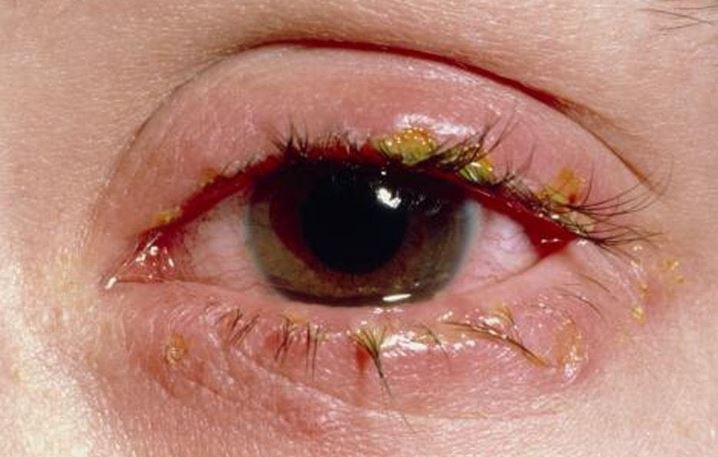
Is Blepharitis Contagious? This is a question that pops up during a discussion on blepharitis with most patients. But before you get the answer to whether it is contagious or not, you’ve to understand what Blepharitis is, its causes, symptoms, and Treatments. Now let’s break it down.
What is Blepharitis
Blepharitis, pronounced bleh-fur-RYE-tis, is a chronic inflammation of the eyelids. It occurs when tiny oil glands near the base of the eyelashes become clogged, causing irritation and redness. It usually affects both eyes along the edges of the eyelids. Both upper and lower lids can be affected. Blepharitis doesn’t cause permanent damage to your eyesight.
Types of Blepharitis
There are two types of blepharitis- Anterior and Posterior Blepharitis, and individuals can have one or both types together:
Anterior blepharitis: This affects the area where your eyelashes attach to your eyelid. Bacteria on your skin or dandruff from your scalp or eyebrows can cause this. Other causes are allergies or mites.
Posterior blepharitis: Affects the area on the inner edge of the eyelid, which touches the eye. A common cause is clogged oil glands in your eyelids. However, other causes are skin conditions like rosacea and scalp dandruff.
Causes of Blepharitis
The exact cause of blepharitis is unknown (idiopathic), but there can be some contributing factors, including:
- A clogged or malfunctioning oil gland usually happens when you have oily skin.
- Allergies to dust, makeup, contact lens solution, etc.
- Lice or Demodex mites (demodicosis): microscopic mites that live in the lash follicles and interfere with oil production on the eyelid margins.
- Seborrheic dermatitis: a skin condition that results in oily, flaky skin and can also cause blepharitis.
- Rosacea: an inflammatory condition that affects the skin of the face, and can also lead to anterior blepharitis.
People with blepharitis tend to have multiple types of bacteria. The most common types found in people with anterior blepharitis, in descending order, are: Staphylococcus epidermidis, Staphylococcus aureus, Propionibacterium, Corynebacteria, and Moraxella.
Signs and Symptoms of Blepharitis
The common symptoms of blepharitis include the following:
- Feeling like there is something on your eye (Foreign Body Sensation)
- Red and swollen eyes or eyelids
- Experiencing Burning or stinging sensation in eyes
- Dry Eye or Tearing, foamy tears, or small bubbles in tears
- Itching
- Sensitivity to light
- Crusty flakes on eyelids or eyelashes
Other symptoms which may be considered severe symptoms of blepharitis include:
- Blurry vision
- Loss of eyelashes (Madarosis)
- Cornea oedema
- Stye (a red, painful bump on the eyelid) and Chalazion (a hard, painless lump on the eyelid)
Is Blepharitis Contagious?
Now with the above information, let’s answer the question, Is blepharitis contagious? The simple answer is No, blepharitis is not contagious, unlike other eye conditions such as acute hemorrhagic conjunctivitis. Despite this condition being common and affecting more than 30 million Americans doesn’t mean you can catch it from someone.
As listed earlier, Bacterial infection or bacterial overgrowth is the most common cause of blepharitis and most people have these blepharitis-causing bacteria living on the skin without causing any problems unless they overgrow. And because most people have it on their skin, it’s not contagious. It doesn’t have to move from one person to another for infection to occur.
Treatments for Blepharitis
Treatment for blepharitis requires that you practice good eye hygiene to keep the eyelids clean and free of crusts, you can do the following to achieve this:
- Wash your hands with soap and water.
- Mix warm water with a mild cleanser, like baby shampoo.
- Dip a clean and soft cloth in the warm water and cleanser mixture.
- Press the cloth against your closed eye for a few minutes to loosen crusty deposits on the eyelids. This can also help keep your oil glands from clogging.
- Lift the eyelid away from your eye and gently rub the base of the lashes with a washcloth. Lifting helps to avoid damaging your cornea.
- Rinse your eyelids with warm water and gently pat dry with a clean towel.
- Repeat these steps on your other.
Aside from these steps, your doctor may take any of the following decisions to manage your blepharitis:
- Corticosteroid eye drops or ointments to control inflammation
- Antibiotic eye drops or ointment may help resolve the bacterial infection and reduce irritation. Cases that persist may require an oral antibiotic, such as doxycycline or azithromycin.
- Treating blepharitis by treating the root cause such as rosacea or dandruff.
How to Prevent Blepharitis and Eye Infections
You can practice the following to reduce your chances of getting Blepharitis or any eye infection:
General ways you can prevent eye infections include:
- Avoid touching your eyes or face with dirty hands.
- Frequently wash your face and hands.
- Wash your bedsheets and pillowcases frequently.
- Avoid sharing personal stuff like makeup products with other people.
- Disinfect reusable contact lenses every day with a contact solution.




